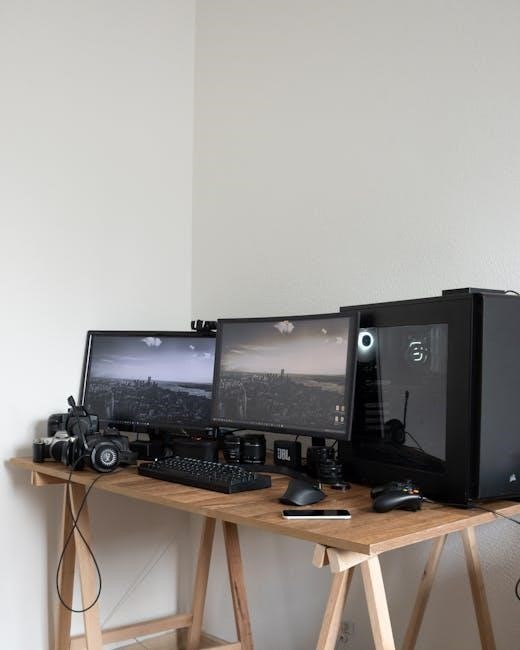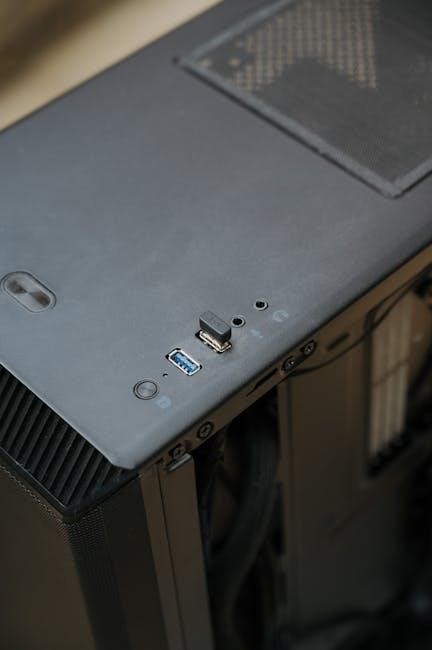The HP 450e Tower Desktop PC is a reliable and high-performance computer designed for business needs, offering versatility and scalability for small to medium enterprises.
1.1 Overview of the HP 450e Tower Desktop PC
The HP 450e Tower Desktop PC is a robust, business-oriented system designed for reliability and performance. It offers scalable configurations to meet diverse needs, making it ideal for small to medium-sized businesses. With a focus on efficiency and durability, this desktop provides essential features for everyday tasks while allowing flexibility for upgrades and customization to adapt to evolving workplace demands.
1.2 Key Features and Benefits
The HP 450e Tower Desktop PC offers a range of key features, including powerful processor options, expandable storage capabilities, and robust security tools. It supports essential business applications with ease, ensuring reliable performance for daily tasks. Energy-efficient design and customizable configurations make it a cost-effective solution for businesses. Additionally, its durable build and easy maintenance options enhance long-term productivity and user satisfaction.

Unboxing and Initial Setup
Unbox and inspect the HP 450e Tower PC, ensuring all components are included. Connect peripherals, plug in the power cord, and follow setup instructions carefully.
2.1 What’s Included in the Box
The HP 450e Tower Desktop PC box includes the tower unit, power cord, HDMI cable, USB keyboard, mouse, and user manual. Additional items like speakers may be optional.
2.2 Connecting Peripherals and Power
Connect the power cord to the desktop and an electrical outlet. Attach the keyboard, mouse, and monitor to the respective ports. Plug in any additional peripherals like speakers or USB devices. Ensure all cables are securely connected. Turn on the PC and follow the on-screen instructions to complete the initial setup. Ground yourself to prevent static discharge during connections.
Safety Precautions and Guidelines
Avoid static discharge by grounding yourself using a wrist strap or unpainted metal surface. Handle components carefully to prevent damage. Follow all safety guidelines to ensure personal and equipment safety.
3.1 General Safety Information
Always follow safety guidelines to protect yourself and the equipment. Disconnect the power cord before servicing. Avoid static discharge by grounding yourself with a wrist strap or unpainted metal surface. Handle components carefully to prevent damage. Ensure proper ventilation and avoid overheating. Keep the area clean and dry. Refer to the manual for detailed safety measures and precautions to ensure safe operation and maintenance of the HP 450e Tower Desktop PC.
3.2 Avoiding Electrostatic Discharge
Electrostatic discharge (ESD) can damage sensitive components. To prevent ESD, ground yourself using a wrist strap or touch an unpainted metal surface. Work on an anti-static surface and handle components by the edges. Avoid walking on carpets or wearing synthetic fabrics that generate static. Proper grounding ensures safe handling of internal parts during maintenance or upgrades of the HP 450e Tower Desktop PC.

System Specifications and Hardware Overview
The HP 450e Tower Desktop PC features flexible hardware options, including multiple processor choices, scalable memory configurations, various storage solutions, and integrated graphics capabilities for enhanced performance.
4.1 Processor and Memory Options
The HP 450e Tower Desktop PC offers versatile processor options, including Intel Core and Pentium processors, delivering efficient performance for everyday tasks. It supports up to 64GB of DDR4 memory, ensuring smooth multitasking and scalability for demanding applications. The system allows for dual-channel memory configurations, enhancing bandwidth and overall system responsiveness. This flexibility makes it ideal for both basic office use and more resource-intensive workflows.
4.2 Storage and Graphics Capabilities
The HP 450e Tower Desktop PC offers flexible storage options, including HDD and SSD choices, with support for up to 2TB of storage. Graphics capabilities include integrated Intel UHD Graphics for everyday tasks and optional dedicated NVIDIA GPUs for enhanced performance. The system supports up to 64GB of DDR4 memory, ensuring smooth multitasking and scalability for demanding applications. This flexibility makes it ideal for both basic office use and more resource-intensive workflows.
Operating System and Software Setup
The HP 450e Tower Desktop PC offers automatic OS installation and activation, typically completed in 5-10 minutes, with essential software pre-installed for a hassle-free start, ensuring efficiency.
5.1 Installing the Operating System
Installing the operating system on the HP 450e Tower Desktop PC is a streamlined process. The system automatically initiates OS setup upon first boot, guiding you through activation and initial configuration. This process typically takes 5 to 10 minutes, ensuring a smooth and efficient experience. Essential drivers and software are pre-installed, minimizing manual intervention and ensuring system stability from the start.
5.2 Updating Drivers and Firmware
The HP 450e Tower Desktop PC comes with essential drivers pre-installed for smooth operation. Regular updates are crucial for optimal performance and security. Use HP’s official tools, such as HPE Software Center, to download and install the latest drivers and firmware. Visit the HP support website for patches and updates, ensuring your system remains up-to-date and secure.
Maintenance and Upkeep
Regular maintenance ensures optimal performance. Clean dust from vents, check hardware connections, and update software. Schedule periodic inspections to keep your HP 450e running smoothly always.
6.1 Cleaning the Desktop PC
Regularly clean the HP 450e Tower PC to prevent dust buildup. Use compressed air to gently remove dust from vents and fans. Disconnect the power before cleaning. Avoid liquids, as they can damage internal components. Ground yourself to prevent static discharge. Clean the exterior with a soft, dry cloth. This maintenance ensures proper airflow and optimal system performance over time.
6.2 Monitoring System Health
Monitor the HP 450e Tower PC’s health by checking CPU, RAM, and storage usage via Task Manager or HP-specific tools; Ensure proper cooling by reviewing system temperatures. Regularly inspect for hardware issues or errors. Use diagnostic tools to assess performance and identify potential bottlenecks. Maintain optimal disk space to prevent slowdowns and ensure smooth operation. Address any alerts or warnings promptly to maintain system stability and longevity.
Troubleshooting Common Issues
Troubleshoot common issues like boot failures, network connectivity, or slow performance by running diagnostics, checking BIOS settings, updating drivers, and performing system health checks regularly.
7.1 Diagnosing Boot Problems
Diagnose boot issues by checking power supply, BIOS settings, and hardware connections. Run system diagnostics to identify firmware or OS-related faults. Ensure all components are properly connected and configured. If issues persist, restore BIOS defaults or reinstall the operating system. Regularly update drivers and firmware to prevent compatibility problems. Always ground yourself to avoid static discharge damage during internal inspections.
7.2 Resolving Network Connectivity Issues
To resolve network issues, restart the router and ensure all cables are securely connected. Check the network adapter settings in the BIOS and enable it if disabled. Install the latest network drivers from HP Support Assistant. Verify IP configuration and DNS settings. Reset network stack or perform a system restore if problems persist. Ensure antivirus software is updated and not blocking connections.
Upgrading and Customizing Hardware
The HP 450e Tower PC allows easy hardware upgrades, such as adding RAM, storage, or a dedicated GPU. Ensure compatibility with HP specifications for optimal performance.
8.1 Adding RAM or Storage
To enhance performance, users can upgrade the HP 450e Tower PC by adding RAM or storage. Ensure the system is powered off and grounded to prevent ESD damage. Open the tower case carefully, locate the DIMM slots for RAM installation, and SATA ports for additional storage. Always refer to the manual for compatible specifications and installation guidelines to avoid hardware conflicts and ensure optimal functionality.
8.2 Installing a Dedicated Graphics Card
Installing a dedicated graphics card enhances the HP 450e Tower PC’s visual performance. Power off the system, ground yourself to prevent ESD, and open the case. Locate the PCIe slot, remove the expansion slot cover, and gently align the graphics card. Secure it firmly, reconnect cables, and boot up. Install the latest drivers from HP’s support site for optimal functionality and compatibility.

Security Features and Best Practices
The HP 450e Tower PC includes BIOS password protection and secure boot options. Enable firewall and antivirus software, and regularly update firmware for enhanced security.
9.1 Enabling BIOS Password and Security
To enhance security, enable BIOS password protection on the HP 450e Tower PC. Access the BIOS by pressing the designated key during startup. Set a strong password under the security tab and enable Secure Boot to ensure only authorized software loads. Additionally, utilize drive encryption and regular firmware updates to safeguard sensitive data and maintain system integrity.
9.2 Managing User Accounts and Permissions
Create strong passwords and assign user permissions to ensure secure access. Use Windows built-in tools to manage accounts, set parental controls, or restrict access to sensitive files. Regularly review user privileges to maintain security and compliance. Enable multi-factor authentication for enhanced protection and monitor account activity to detect unauthorized access or suspicious behavior.
Backup and Recovery Options
Regular backups ensure data safety. Use HP Recovery Manager or third-party tools to create system backups. Recovery options include restoring from backups or reinstalling the OS.
10.1 Creating a System Backup
Creating a system backup is essential for data protection. Use HP Recovery Manager to generate a backup of your operating system, settings, and files. Alternatively, third-party tools like Acronis or Macrium can create full system images. Regular backups ensure data safety and allow quick restoration in case of hardware failure or software issues. Always store backups on external drives for added security.
10.2 Using Recovery Tools
The HP 450e Tower Desktop PC includes recovery tools to restore your system to its original state. Use HP Recovery Manager to reboot and access the recovery environment. From there, you can restore the OS, drivers, and settings. Ensure backups are created before proceeding. These tools help fix boot issues or revert changes, ensuring system stability and performance. Regular use is recommended for maintaining optimal functionality.

Advanced Configuration and Optimization
Explore BIOS settings for customizing system performance, optimizing processor settings, and managing memory allocation to enhance productivity and tailor the PC to specific workflow demands efficiently.
11.1 BIOS Settings and Configuration
Access the BIOS to configure boot order, enable security features, and adjust power management settings. Navigate through menus to set passwords, monitor hardware health, and optimize performance. Ensure proper configuration to maintain system stability and security, following the manual’s guidance for specific setups and troubleshooting common BIOS-related issues efficiently.
11.2 Optimizing Performance for Specific Tasks
Enhance performance by adjusting settings based on workload demands. For heavy tasks, prioritize CPU or GPU-intensive processes in BIOS. Enable power management features to balance efficiency and performance. Upgrade hardware like RAM or storage for improved multitasking. Regularly monitor system health and close unnecessary background applications to ensure optimal functionality for demanding applications or specialized workflows.
Environmental and Energy Efficiency
The HP 450e Tower Desktop PC features energy-efficient components and power management settings to reduce energy consumption, aligning with eco-friendly practices and minimizing environmental impact.
12.1 Power Management Features
The HP 450e Tower Desktop PC incorporates advanced power management features, including energy-efficient components and customizable power-saving modes. These features help reduce energy consumption while maintaining performance. The system supports dynamic power adjustment, allowing users to optimize energy use based on workload demands. Additionally, the PC complies with international energy efficiency standards, ensuring eco-friendly operation and lower utility costs over time.
12.2 Reducing Energy Consumption
The HP 450e Tower Desktop PC offers multiple ways to reduce energy consumption. Enable power-saving modes to lower energy use during idle periods. Adjust settings in the BIOS or operating system to optimize power efficiency. Additionally, using energy-efficient hardware and turning off the PC when not in use can significantly reduce energy costs and environmental impact over time.
The HP 450e Tower Desktop PC is a versatile and reliable system, offering strong performance and energy efficiency. With comprehensive support and regular updates, it remains a solid choice for business and personal use, ensuring long-term productivity and satisfaction.
13.1 Summary of Key Points
The HP 450e Tower Desktop PC is a reliable and efficient system designed for both business and personal use, offering strong performance, scalability, and energy efficiency. It features robust hardware, user-friendly setup, and comprehensive security options. Regular updates and dedicated support ensure optimal functionality and longevity, making it a solid choice for various computing needs and preferences.
13.2 Future Updates and Support
HP remains committed to providing regular software updates and robust technical support for the 450e Tower Desktop PC. Users can expect timely driver updates, security patches, and firmware enhancements to maintain optimal performance. Dedicated customer service and online resources ensure comprehensive assistance, while HP’s support website offers manuals, troubleshooting guides, and community forums for extended help and maintenance.

